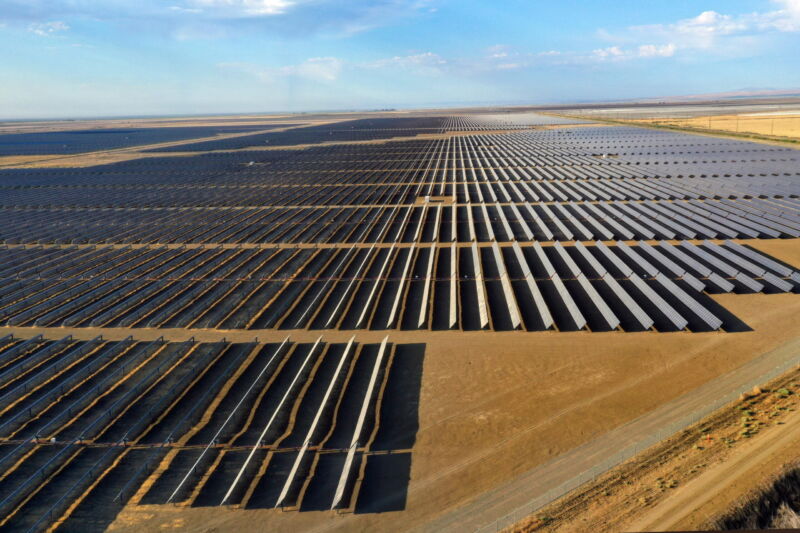

California wants to build more solar farms but needs more power lines
source link: https://arstechnica.com/tech-policy/2023/03/california-wants-to-build-more-solar-farms-but-needs-more-power-lines/
Go to the source link to view the article. You can view the picture content, updated content and better typesetting reading experience. If the link is broken, please click the button below to view the snapshot at that time.

Shocking reality —
California wants to build more solar farms but needs more power lines
Transmission is now a big tension point for clean energy developers across the US.
Emma Foehringer Merchant, Inside Climate News - 3/29/2023, 1:26 PM

California’s San Joaquin Valley, a strip of land between the Diablo Range and the Sierra Nevada, accounts for a significant portion of the state’s crop production and agricultural revenues. But with the state facing uncertain and uneven water supply due to climate change, some local governments and clean energy advocates hope solar energy installations could provide economic reliability where agriculture falters due to possible water shortages.
In the next two decades, the Valley could accommodate the majority of the state’s estimated buildout of solar energy under a state plan forecasting transmission needs [PDF], adding enough capacity to power 10 million homes as California strives to reach 100 percent clean electricity by 2045. The influx of solar development would come at a time when the historically agriculture-rich valley is coping with new restrictions on groundwater pumping. Growers may need to fallow land. And some clean energy boosters see solar as an ideal alternative land use.
But a significant technological hurdle stands in the way: California needs to plan and build more long-distance power lines to carry all the electricity produced there to different parts of the state, and development can take nearly a decade. Transmission has become a significant tension point for clean energy developers across the US, as the number of project proposals balloons and lines to connect to the grid grow ever longer.
Existing lines are not enough to accommodate the spike in large clean energy installations, planning new transmission has lagged, and regulators have struggled to keep up with studying and processing all the projects looking to hook up to the grid.
Advertisement“It’s undeniable that we do need major funding for transmission buildout in California, and frankly, the West, to meet our clean energy goals,” said Dian Grueneich, a former commissioner on the California public utility commission. “The issue is where, how much, when, et cetera, … It’s probably the most complex area there is.”
Compared to other regions, California has been relatively proactive in assessing the grid needs of a decarbonized future, said Rob Gramlich, founder of consulting firm Grid Strategies LLC. But there’s still much work to do.
“It’s a systemic problem across the country. We have interconnection queue process problems in most regions,” said Gramlich. “The problem is more acutely felt in any region that is going faster on the energy transition. And California is second to no one on the pace and ambition of its clean energy transition.”
That challenge could cause particular difficulties in regions of California expecting a big scale-up in renewable energy, like the North Coast, where offshore wind developers are planning projects, or areas of the Central Valley eyed by solar companies and facing a potential downturn in the water available for crops.
“Short of water”
In coming years, more land in California once used for agriculture could host solar. In 2014, the state approved the Sustainable Groundwater Management Act, an effort to reduce over-pumping from aquifers that had caused land in certain parts of the state to sink. The law requires local water managers to submit plans to the state that demonstrate how they’ll keep industries and people from pulling water out of underground stores more quickly than it can be replenished.
California farmers get water for their crops via a combination of underground supplies and diversions from reservoirs, lakes, and other stores managed by the state and the federal Bureau of Reclamation. The new groundwater regulations, combined with climate change and other environmental regulations, could lead to a 20 percent drop in annual average water supplies in the San Joaquin Valley by 2040, according to a February analysis from the Public Policy Institute of California (PPIC).
Page:
Recommend
-
 11
11
April 13, 2021
-
 7
7
EGEB: The Navajo Nation finalizes leases for two more solar farms In today’s Electrek Green Energy Brief (EGEB): The Navajo Nation will build two more solar farms that will create jobs, revenue, and electricity. Joe...
-
 7
7
5171 members Technology Technology on Digg: the best articles, videos, tweets, and original content that the web is talking a...
-
 15
15
Orbiting solar farms not as out-of-this-world as you think Experts say they could provide 24-hour reliable energy and meet a quarter of Britain’s electricity needs
-
 13
13
Clean TechSolar window start-up aims to turn skyscrapers into vertical solar farms with investment from major window manufacturerPublished Wed, Jan...
-
 12
12
-
 9
9
How solar farms in space might beam electricity to EarthPublished6 days ago
-
 10
10
Could floating solar farms survive out at sea?Published15 hours ago
-
 7
7
This company has invented automated robots that can build huge solar farms
-
 3
3
About Joyk
Aggregate valuable and interesting links.
Joyk means Joy of geeK